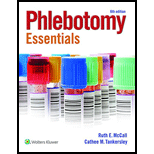
Concept explainers
Introduction: Preanalytical or preexamination phase is considered as an important part of the total testing process. It describes the procedures that occur before an analysis. The levels of many blood components usually exhibit two types of variations or fluctuations namely diurnal variation and circadian variation.
Answer to Problem 1SRQ
Correct answer: “Peak levels of cortisol typically occur around 08:00 hours.”
Hence, the correct answer is option b.
Explanation of Solution
Reason for the correct answer:
Diurnal variation is the type of variation that happens daily. There are several factors that play an important role in this type of variation including activity, posture, eating, being awake or asleep, daylight, and darkness. The example for diurnal variation includes cortisol; its peak level normally occurs later in the morning, around 8:00 A.M.
Option b. is given as “cortisol”.
An analyte that typically occurs around 08:00 hours is cortisol.
Hence, the correct answer is option b.
Reasons for incorrect answers:
Option a. is given as “Bilirubin”.
An analyte that typically occurs around 08:00 hours is cortisol, not bilirubin. Bilirubin is a degradation product of hemoglobin.
Hence, option a. is incorrect.
Option c. is given as “Eosinophil”.
An analyte that typically occurs around 08:00 hours is cortisol, not eosinophil. Eosinophil is a blood cell.
Hence, option c. is incorrect.
Option d. is given as “Glucose”.
An analyte that typically occurs around 08:00 hours is cortisol, not glucose. Glucose is a carbohydrate molecule.
Hence, option d. is incorrect.
Hence, options a., c., and d. are incorrect.
The peak cortisol levels usually occur later in the morning, around 8:00 A.M.
Want to see more full solutions like this?
- explain an abdominal exam?arrow_forwardDiscuss β -Lactam antibiotics under the following subheadings Classifications of penicillins Classification of Cephalosporins General Mechanism of Actions Clinical Indications of penicillins and cephalosporins Adverse effects of β-lactamsarrow_forwarda. Define neoplasm b. Differentiate between benign and malignant tumours c. Describe the molecular basis of cancerarrow_forward
- differentiate the extra heart sounds S3,S4, murmurs and gallopsarrow_forward• Define shock and list types of shock • Discuss pathogenesis of septic shock. • Enumerate the stages of shock. • Define oedema and describe the pathophysiologic mechanisms of oedema with examples.arrow_forwardDiscuss Hypertension under the following headings: Definition Diagnosis Non-pharmacological intervention Drugs Classification Management of a Hypertensive emergencyarrow_forward
- Explain how the answer could be 2 or 1.8 WITHOUT changing the questionarrow_forwardoverview of the neurological system, cranial nerves and what part of the body it innervatesarrow_forwarddifferentiate structure and function of the peripheral vascular system. what are the normal and abnormal findings of the peripheral arterioles and peripheral venous systemarrow_forward
 Phlebotomy EssentialsNursingISBN:9781451194524Author:Ruth McCall, Cathee M. Tankersley MT(ASCP)Publisher:JONES+BARTLETT PUBLISHERS, INC.
Phlebotomy EssentialsNursingISBN:9781451194524Author:Ruth McCall, Cathee M. Tankersley MT(ASCP)Publisher:JONES+BARTLETT PUBLISHERS, INC. Gould's Pathophysiology for the Health Profession...NursingISBN:9780323414425Author:Robert J Hubert BSPublisher:Saunders
Gould's Pathophysiology for the Health Profession...NursingISBN:9780323414425Author:Robert J Hubert BSPublisher:Saunders Fundamentals Of NursingNursingISBN:9781496362179Author:Taylor, Carol (carol R.), LYNN, Pamela (pamela Barbara), Bartlett, Jennifer L.Publisher:Wolters Kluwer,
Fundamentals Of NursingNursingISBN:9781496362179Author:Taylor, Carol (carol R.), LYNN, Pamela (pamela Barbara), Bartlett, Jennifer L.Publisher:Wolters Kluwer, Fundamentals of Nursing, 9eNursingISBN:9780323327404Author:Patricia A. Potter RN MSN PhD FAAN, Anne Griffin Perry RN EdD FAAN, Patricia Stockert RN BSN MS PhD, Amy Hall RN BSN MS PhD CNEPublisher:Elsevier Science
Fundamentals of Nursing, 9eNursingISBN:9780323327404Author:Patricia A. Potter RN MSN PhD FAAN, Anne Griffin Perry RN EdD FAAN, Patricia Stockert RN BSN MS PhD, Amy Hall RN BSN MS PhD CNEPublisher:Elsevier Science Study Guide for Gould's Pathophysiology for the H...NursingISBN:9780323414142Author:Hubert BS, Robert J; VanMeter PhD, Karin C.Publisher:Saunders
Study Guide for Gould's Pathophysiology for the H...NursingISBN:9780323414142Author:Hubert BS, Robert J; VanMeter PhD, Karin C.Publisher:Saunders Issues and Ethics in the Helping Professions (Min...NursingISBN:9781337406291Author:Gerald Corey, Marianne Schneider Corey, Cindy CoreyPublisher:Cengage Learning
Issues and Ethics in the Helping Professions (Min...NursingISBN:9781337406291Author:Gerald Corey, Marianne Schneider Corey, Cindy CoreyPublisher:Cengage Learning





